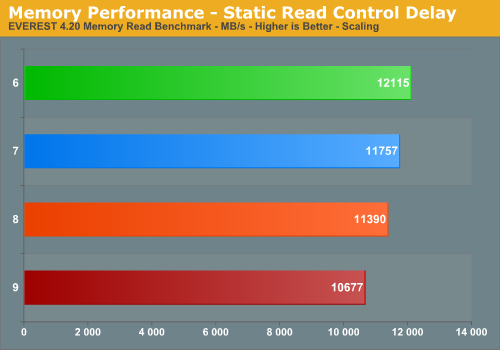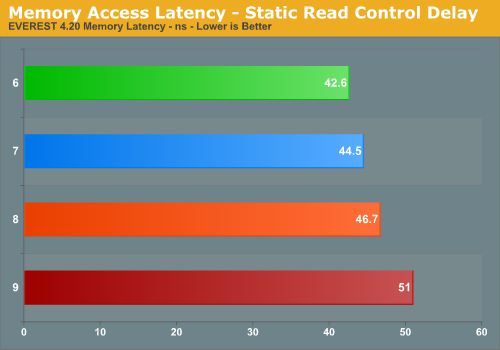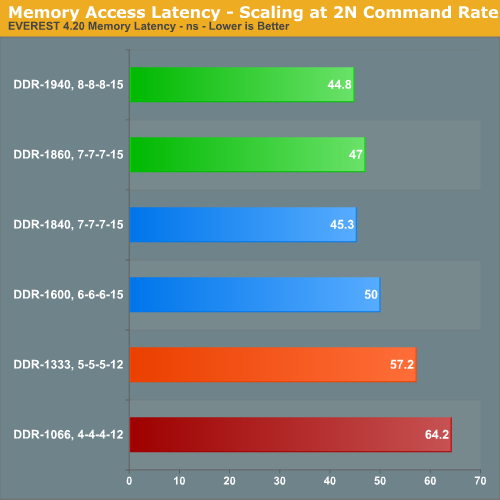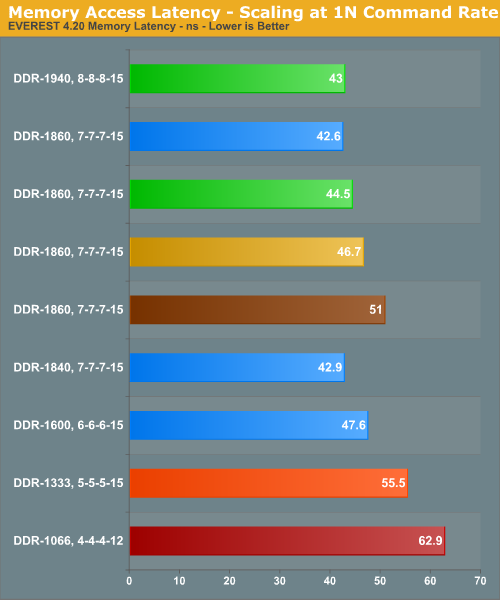ASUS P5E3 Deluxe Overclocking: DDR3 Takes Front Stage
by Kris Boughton on November 20, 2007 4:00 AM EST- Posted in
- CPUs
Static Read Control Delay and Latency Considerations


This brings us to the coup de grace of BIOS tweaks - Static Read Control Delay. Only recently discovered and popularized by those looking for every last ounce of memory performance, this tweak is sometimes referred to as Performance Level. Don't let this fool you though; just like golf, lower is better. Tragically, this now-essential setting is among the most misunderstood and often overlooked settings when tuning a board.
In this first graph, we can see the affect of varying the Static Read Control Delay setting. The memory was set to DDR-1860 (8x465) with 7-7-7-15 timings and Command Rate 1N. The difference in performance between the loosest setting of 9 and the tightest setting of 6 is outstanding with nearly a 14% increase in memory read performance without even touching the memory. The second graph demonstrates the equally impressive reduction in overall memory access latency.


The previous two graphs helps to illustrate both how Command Rate and Static Read Control Delay (Performance Level) influence the overall memory access latency. Notice that the minimum latencies do not occur at the highest memory speed but rather at the higher FSB/DRAM frequency achievable using a Static Read Control Delay of 6. This helps to support our recommendation that 6 should also be your target value when overclocking. Instead of continuing to push the memory harder and harder, forcing more and more voltage into the modules, back off on the frequency until you find the absolute maximum speed that the MCH will run a Static Read Control Delay of 6. Finally, enable Command Rate 1N and tighten the timings as allowable using a voltage with which your components are comfortable - this will usually be the motherboard's sweet spot for performance.
These base settings should provide enough knowledge to tune the ASUS P5E3 Deluxe. In fact, a lot of what we have gone over here translates extremely well too many other Intel X38/P35 motherboards, not just from ASUS but Gigabyte, abit, DFI, etc. The big question on everybody's mind should now be whether any of these tweaks made any difference in real-world performance or in synthetic benchmarks. To answer these questions we first look toward 3DMark06. This particular benchmark does a good job of assessing a system's overall ability to process 3D intensive workloads. At the end of the day, frame rate is still king for gaming.


This brings us to the coup de grace of BIOS tweaks - Static Read Control Delay. Only recently discovered and popularized by those looking for every last ounce of memory performance, this tweak is sometimes referred to as Performance Level. Don't let this fool you though; just like golf, lower is better. Tragically, this now-essential setting is among the most misunderstood and often overlooked settings when tuning a board.
In this first graph, we can see the affect of varying the Static Read Control Delay setting. The memory was set to DDR-1860 (8x465) with 7-7-7-15 timings and Command Rate 1N. The difference in performance between the loosest setting of 9 and the tightest setting of 6 is outstanding with nearly a 14% increase in memory read performance without even touching the memory. The second graph demonstrates the equally impressive reduction in overall memory access latency.


| Memory Access Latency Color Coding Legend | |
| Color | Static Read Control Delay (Performance Level) |
| Red | 4 |
| Orange | 5 |
| Light Blue | 6 |
| Lime Green | 7 |
| Dark Gold | 8 |
| Brown | 9 |
The previous two graphs helps to illustrate both how Command Rate and Static Read Control Delay (Performance Level) influence the overall memory access latency. Notice that the minimum latencies do not occur at the highest memory speed but rather at the higher FSB/DRAM frequency achievable using a Static Read Control Delay of 6. This helps to support our recommendation that 6 should also be your target value when overclocking. Instead of continuing to push the memory harder and harder, forcing more and more voltage into the modules, back off on the frequency until you find the absolute maximum speed that the MCH will run a Static Read Control Delay of 6. Finally, enable Command Rate 1N and tighten the timings as allowable using a voltage with which your components are comfortable - this will usually be the motherboard's sweet spot for performance.
These base settings should provide enough knowledge to tune the ASUS P5E3 Deluxe. In fact, a lot of what we have gone over here translates extremely well too many other Intel X38/P35 motherboards, not just from ASUS but Gigabyte, abit, DFI, etc. The big question on everybody's mind should now be whether any of these tweaks made any difference in real-world performance or in synthetic benchmarks. To answer these questions we first look toward 3DMark06. This particular benchmark does a good job of assessing a system's overall ability to process 3D intensive workloads. At the end of the day, frame rate is still king for gaming.










25 Comments
View All Comments
Owls - Tuesday, November 20, 2007 - link
DDR2 is hardly "inferior". When comparing 4GB of DDR3 vs 4GB of DDR2, I can build a whole new computer with what I'd have spent on DDR3. It just doesn't make sense right now no matter how you cut it.. and only having 1GB of ram now?TA152H - Tuesday, November 20, 2007 - link
I run most of my machines with 512 MB, so 1 GB is hardly a problem.There are some things you need more memory than 1 GB for.
When I see stuff like "It doesn't make sense no matter how you cut it", I instantly think you're an idiot. You're probably not, but that statement is absurd. There is always a group that the cost of the most expensive, and fastest parts, makes sense. The cost of memory is trivial compared to the cost of salaries, for example, and spending $500 to help someone work faster pays for itself very quickly.
I think the main problem is that most people do not understand that more memory does not always make things faster. I deal with this all the time.
AnnihilatorX - Tuesday, November 20, 2007 - link
Correct me if I am wrongThe increase in FPS you see going from 400x9 to 465x9 is nearly 100% due to increase in CPU frequency
The performance increase of a 465x9 RAM running at 2:1 memory divider would be less than 5% higher than a similar configuration of 465x9 with slower RAM running at lower divider ratios.
That would mean there is no sense to buy a premium DDR3 for $500 extra for what you can do with less than 5% performance sacrifice with the dirt cheap DDR2 RAM.
snarfbot - Sunday, November 25, 2007 - link
no everything you said is correct.the thing that really gets me though, is that pc6400 ddr2 is commonly capable of reaching 485mhz at lower timings. so whats so great about ddr3?
on a p35 you can easily reach the same speed with cheap memory, at cas 5, sometimes even cas 4 with good overclockable ram.
so basically the only benefit that ddr3 has going for it is the lower voltage required, and of course lower temps, not worth the premium. period.
Aivas47a - Tuesday, November 20, 2007 - link
This is one of the best, detailed overclocking guides I've ever seen. Excellent job! I'm especially glad to have the mystery of Transaction Booster, Skew, and Clock Twister in the Asus bios explained.Now, if you guys could just prepare a guide for memory subtimings, the treatise would be complete. :)
Thanks very much for this.